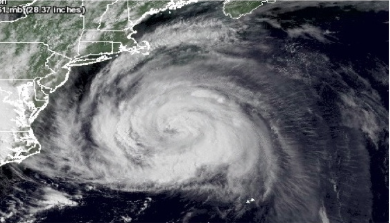OCEAN: RESEARCH ARTICLE
In mid-November 2013, Cyclone Cleopatra tore through the Italian island Sardinia, exacting long lasting damage in a matter of hours. The intense extratropical cyclone poured almost 18 inches of rain in an hour and a half and nearly destroyed this beloved western Mediterranean tourist destination. When rivers broke their banks it caused flash floods that swept away cars, washed bridges out and took the lives of at least 18 people.
A cyclone, by definition, is a system of winds that rotate around a low pressure area. They belong to a low pressure storm family that are categorized as cyclones, typhoons or hurricanes depending on geographical region. There are a variety of cyclone magnitudes ranging from mild to severe, with the largest of the low pressure systems being cold core and, as in this circumstance, extratropical. These mid-latitude cyclones can occur any time and are present in both hemispheres, and during the winter and when severe they are generally called “nor’easters.” Extratropical cyclones form as waves along weather fronts, and favor warm sea surface temperatures and atmospheric instability. Cyclone Cleopatra developed from northern cold air entering the Mediterranean and interacting with humid warm air, and because of increased sea surface temperatures due to climate change, it is highly possible that global warming strengthened this system since the difference between air and water temperature would be larger than before.
There was no choice by Italian officials other than to declare a state of emergency for this region within 24 hours of Cyclone Cleopatra’s commencement. It has been estimated that over 2,000 people had been affected by this natural disaster and £17 million for emergency relief has been allocated by the Italian government. The northeastern port city Olbia was among the most severely hit, and areas had been submerged in almost 10 feet of water-ruining roads and destroying homes. For comparison, the amount of water that fell in 90 minutes is comparable to the rainfall in the city of Milan over 6 months. A local mayor deemed the storm “apocalyptic,” and experts have stated that this locale has not experienced a storm of this calibre in centuries. Other towns were hit by heavy rains as well coupled with gale force winds, and the heavy rains continued to threaten other parts of Italy, including Rome and Venice, while moving east days later.
The geography of Sardinia has been devastated by Cyclone Cleopatra with its heavy rainfall and winds up to 58 mile per hour. Crops were ripped up and mud was spread across the landscape, which will affect agriculture production indefinitely in the region. Sardinia’s road and bridge infrastructure have been broken and severely damaged. This will not only impede access for relief efforts in the area but also yield the high priority task of rebuilding and repairing immediately. Italy has been in a fiscal recession for over two years, so these responsibilities may have unforeseen consequence by taking a higher toll on the unstable government and complicating restoration plans.
There are bureaucratic complications to this tragedy as well. Italy has experienced more than two years of recession so may not be well prepared to deal with this unexpected crisis financially. An alert system was in effect but the efficiency of it is questionable since evacuation orders had been ignored and it has been said that the weather predictions were understated. Though this event was due to a variety of factors, the risk was said to have been heightened by faulty construction of buildings, especially in coastal areas, and need for better emergency planning.
Needless to say that Cyclone Cleopatra has left a long road of healing and repair for the people of Sardinia. With climate change being very real, and the anthropogenic contributions to it, the potential of this or storms like this occurring again seems to be likely. Hopefully better, advanced preparations for these devastating natural disasters will minimize future detrimental effects and mortalities.
Thank You to OCEAN Researcher Brigid McKenna
For more information:
http://guardianlv.com/2013/11/sardinia-cyclone-prompted-state-of-emergency-in-italy/





